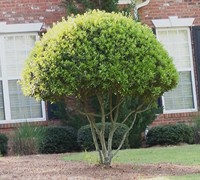
By selecting an appropriate cultivar you can control the form and height of the plant. Cultivars of Wax Myrtleīreeders have developed more than a few cultivars for this popular plant. If you want to limit their spread, prune out suckers as they appear. They can form sizable colonies in excellent growing conditions. That’s because the shrubs tend to sucker. That makes these shrubs potential fire hazards in some areas. This is because they contain aromatic compounds that also happen to be flammable. The leaves, stems and branches of wax myrtle smell good. Keep your eye out for the classic yellowing of the leaf tissue between the veins. Planted in high pH soils, however, these shrubs can get iron chlorosis. They generally do not suffer from any serious plant diseases or show vulnerability to insect pests. Problems and Challenges with Wax Myrtleĭon’t stay up nights worrying about insects attacking your bayberry plants. These trees are very sensitive to cold so, in cooler zones, choose a protected spot. When several shrubs are grown together, they make very effective screens or hedging. That will expose the bark, a very attractive pale shade of gray. If you opt for a tree shape, prune up the canopy and restrict the trunks to one. Wax myrtle can be grown as a small tree or shrub, depending on your landscape needs. When growing wax myrtle, plant it where you can enjoy the bayberry fragrance emitting from the glossy foliage and berries.

The wax myrtle is adaptable to a range of soils, but prefers the soil to be moist. This plant is salt-tolerant and takes sea spray well, making it an exceptional beachfront planting.
#WAX MYRTLE ZONE FULL#
Plant wax myrtle in full sun to part sun or part shade, in an area where roots will not be disturbed. Wax myrtles are natural hosts for Red-Banded Hairstreak butterflies, a beautiful species of pollinator native to the southeastern United States. Flowers appear in spring, and are small with a greenish tint. Grayish white clusters of fruit with a bluish, waxy coating remain on the plant throughout the winter in USDA zones 7 to 9. The fruit of the wax myrtle tree is an important source of food for birds, including the tree swallow, catbird, brown thrasher, and Myrtle Warbler, whose love of the tree earns it its name. Root disturbance or injury results in numerous suckers that must be pruned to keep the plant healthy. When growing wax myrtle, avoid planting annuals and perennials around the roots of this plant. Use the wax myrtle tree in mixed shrub borders and as shade for the deck or patio. As a shrub, it has a rounded, narrow form and is attractive when limbed up for use as a small tree. Wax myrtle often exhibits growth of 3 to 5 feet (1-1.5 m) a year. This is the source of its other name, Southern bayberry. Its waxy berries would be harvested and used to make bayberry candles. That, paired with their high tolerance for salt spray and salinity in the soil, makes them a popular choice for planting in marshes and swamps, on the oceanfront, and along roads.įor years the wax myrtle tree was prized for its fragrance and flammability. Since they fix atmospheric nitrogen, they are not phased by poor or infertile soils. They do well in almost all growing conditions, but tend to do best in slightly acidic, sandy soil with good drainage. Tough and durable, Southern wax myrtle trees do not need kid-glove treatment to thrive. It thrives in USDA hardiness zones 7 through 10.
#WAX MYRTLE ZONE PLUS#
These ornamental features, plus the plant’s easy-care ways have made wax myrtle – also known as Southern bayberry – an extremely popular landscape plant in warm-winter regions.

(When selecting a wax myrtle, be aware that both female and male plants and are needed to produce fruit.) The females bear inconspicuous flowers in spring, followed by clusters of gray-blue, waxy berries beloved by wildlife. As specimen trees, they form many-stemmed canopies of aromatic olive green leaves on smooth, twisted trunks.

There is so much to love about a wax myrtle tree. Read here about growing tips for wax myrtle trees and shrubs. In the South they’re popular grown as hedges, but these attractive trees can also be used as specimens. Wax myrtle ( Myrica cerifera) is a small, broadleaf evergreen shrub that makes an excellent addition to almost any landscape. When to plant: transplant in spring or fall.Soil requirements: good drainage and slightly acidic soils.Sun exposure: partial shade to full sun.Botanical name: Morella cerifera formerly Myrica cerifera.


 0 kommentar(er)
0 kommentar(er)
